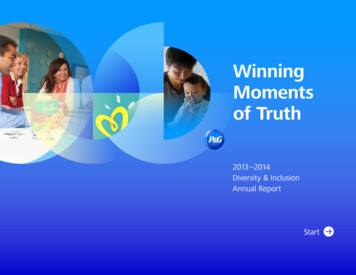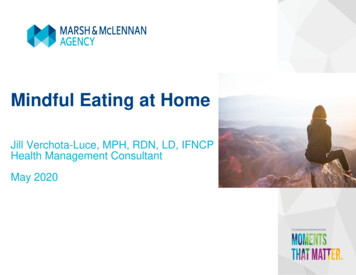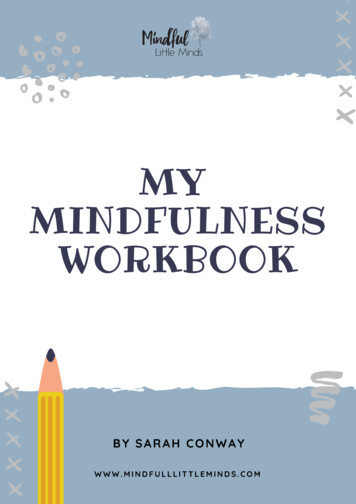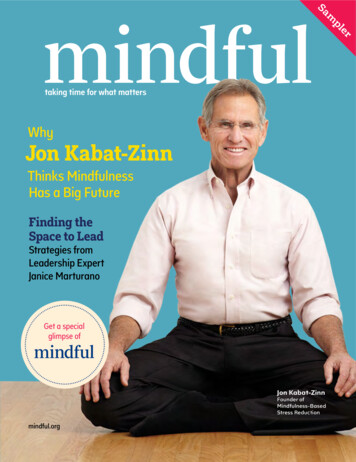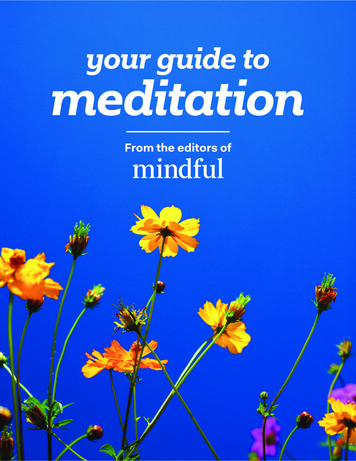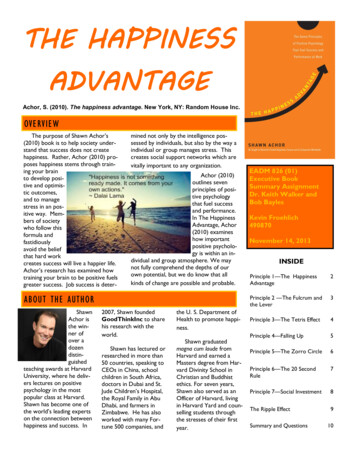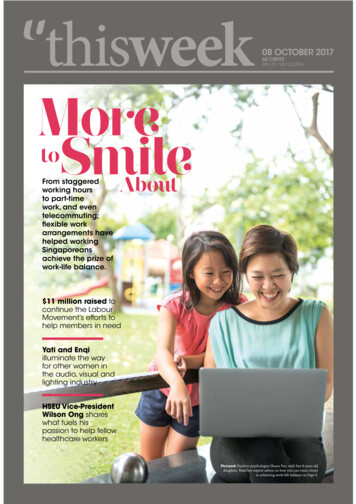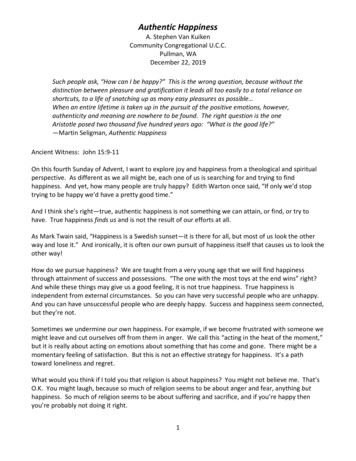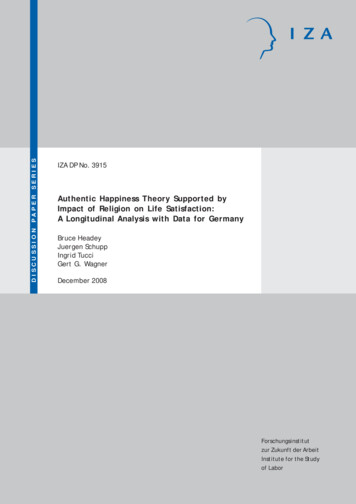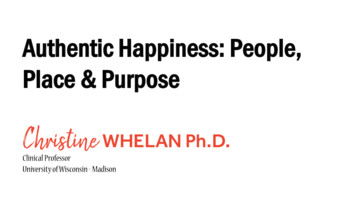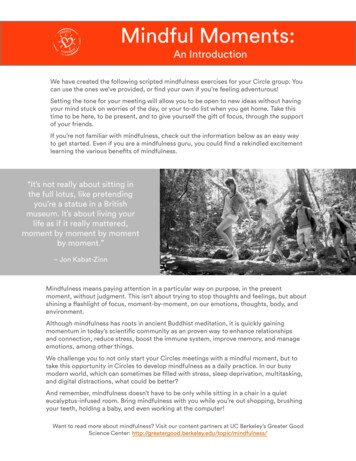
Transcription
Mindful Moments:An IntroductionWe have created the following scripted mindfulness exercises for your Circle group. Youcan use the ones we’ve provided, or find your own if you’re feeling adventurous!Setting the tone for your meeting will allow you to be open to new ideas without havingyour mind stuck on worries of the day, or your to-do list when you get home. Take thistime to be here, to be present, and to give yourself the gift of focus, through the supportof your friends.If you’re not familiar with mindfulness, check out the information below as an easy wayto get started. Even if you are a mindfulness guru, you could find a rekindled excitementlearning the various benefits of mindfulness.“It’s not really about sitting inthe full lotus, like pretendingyou’re a statue in a Britishmuseum. It’s about living yourlife as if it really mattered,moment by moment by momentby moment.”– Jon Kabat-ZinnMindfulness means paying attention in a particular way on purpose, in the presentmoment, without judgment. This isn’t about trying to stop thoughts and feelings, but aboutshining a flashlight of focus, moment-by-moment, on our emotions, thoughts, body, andenvironment.Although mindfulness has roots in ancient Buddhist meditation, it is quickly gainingmomentum in today’s scientific community as an proven way to enhance relationshipsand connection, reduce stress, boost the immune system, improve memory, and manageemotions, among other things.We challenge you to not only start your Circles meetings with a mindful moment, but totake this opportunity in Circles to develop mindfulness as a daily practice. In our busymodern world, which can sometimes be filled with stress, sleep deprivation, multitasking,and digital distractions, what could be better?And remember, mindfulness doesn’t have to be only while sitting in a chair in a quieteucalyptus-infused room. Bring mindfulness with you while you’re out shopping, brushingyour teeth, holding a baby, and even working at the computer!Want to read more about mindfulness? Visit our content partners at UC Berkeley’s Greater GoodScience Center: http://greatergood.berkeley.edu/topic/mindfulness/
Mindful Moments:Mindful BreathingAnchor your Circle to the here and now by using your breath. Lead this “balloon breath”exercise as a starting point to your mindfulness practice. These exercises are most powerfulif someone guides it and everyone else follows along.Instructions and script:1.2.3.4.5.6.7.8.Read the script below aloud in a slow, gentle voice at a rhythmic pace with manypauses.Have people sit or lie on the floor. If they prefer to stay on their chairs, that’s okaytoo.“Please get into your ‘mindful bodies’ – being as still as possible as quiet aspossible spines straight, with your eyes gently closed. Let your hands andarms rest in a relaxed position.”“Inhale slowly as if blowing up a balloon in your stomach.”“Exhale slowly and notice the balloon fall.”“Inhale, noticing how your stomach moves out, away from the body. Exhale,noticing how your stomach moves closer to the body.”“Repeat this balloon breath 5-10 times. Observe how you feel as you inhale andas you exhale.”Ask your Circle about their first mindful experience. What did they feel?Since breathing is something you all do all the time, it is one of the best tools you have tobring you into the present moment. No matter what situation you are in, you can alwaysplace your attention on breathing in and out – use your breath as an anchor.As you focus on breath, living in the ‘now’ will feel more clear and peaceful, even when yourenvironment is chaotic. It is not meant as a prescription for tuning out the world, but tuningin with open awareness.Other Project Happiness picks:Guided breathing: http://www.freemindfulness.org/downloadTime’s breathing exercises: exercises-to-relax-in10-minutes-or-less/Dr. Weil’s 3 breathing techniques: irit/stressanxiety/breathing-three-exercises/
Mindful Moments:Mindful ListeningLead this “listening to the bell” exercise to encourage mindful listening. This is a simplepractice and can be repeated daily, even when you’re not meeting with your Circle.You will need a “mindfulness bell,” or a rain stick – anything with a sustained sound. Ifyou don’t have access to any of these, you can use this online recording: http://www.onlinemeditationtimer.com.Instructions and script:1.2.3.4.5.6.7.8.9.Read the script below aloud in a slow, gentle voice at a rhythmic pace with manypauses.“Today’s mindful moment is a practice in listening mindfully.”“Please get into your ‘mindful bodies’ – last time we discussed that this meansbeing still and quiet, sitting upright, with your eyes gently closed.”“Now place all your attention on the sound you are about to hear. Listen untilthe sound is completely gone.”Ring the bell. As it begins to ring say, “Please raise your hand when you can nolonger hear the sound.”When most or all have raised their hands, you can say, “Now slowly move yourhand over your stomach or chest, and just feel your breathing, rememberingthe balloon breathing we did last week.”You can help your Circle stay focused during the breathing with reminders like,“Just breathing in breathing out ”Ring the bell again, and have your group raise their hands when they can no longerhear it.Invite feedback on mindful listening. Ask: How does listening to the bell translateinto listening to people and daily conversations?In order to tune in to the very last sound of the bell, there couldn’t be any other noiseor interruptions. Similarly, when we are tuning in to a conversation, mindfulness allowsour thoughts to stay focused on who is speaking, and to remain open to their opinion. Inlistening intently, we can also stay aware of our emotional landscape and what is happeningwithin, without judgment.Other Project Happiness picks:Guided sounds and thoughts: fulness/Guided mindful listening: ning/
Mindful Moments:Mindful Body AwarenessGuide this “body scan” exercise to encourage being fully present in your body, withouttrying to change it, which is sometimes referred to as a feeling of “bodyfullness.”Instructions and script:1. “Today’s mindful moment is called a body scan. You learned how to do mindfulbreathing, how that can relax you and make you more calm. Now we’re goingto scan around the whole body, and go through it like a spotlight, section bysection, so you will know how to be mindful of your whole body.”2. Read the script below aloud in a slow, gentle voice at a rhythmic pace with manypauses. Have people sit in chairs for this exercise.3. “Please get into your ‘mindful bodies.’”4. “First feel yourself on your chair, feel your feet on the floor, your toes, yourheels. Are they heavy or light? Feel your seat on the chair, your back leaningon the back of the chair, or if you’re lying down feel your body melt onto whereyou are lying.”5. “Where your body is touching the chair or floor, is it soft or hard? Let’s softenthose edges.”6. “Bring your hands together, and rest them in your lap. Notice how your handsfeel. Are they heavy or light, warm or cool?”7. “Notice these things about every part of the body we put our flashlight ofattention on, starting with your feet.”8. “What about your knees, your legs.”9. “Put your attention on your belly. Breathe in and feel it fill up with air, thenbreathe out the air.”10. “With your hands clasped in your lap, put your spotlight of attention on yourfingertips.”11. “Then your elbows.Your shoulders.Your back.Your neck.”12. “Put your spotlight of attention on your face, your mouth, your eyes, your ears,the top of your head.”13. Allow your group to breathe silently for a few moments.14. “And when you’re ready, open your eyes.”15. Invite feedback from the group about their mindful experience. Questions to ask:What is one thing you noticed? Is there one part of your body that you wanted yourflashlight of attention to stay on for longer? Did it make you feel more relaxed?The body scan is a good mindful exercise to do before you go to sleep, before your busyday, or even sports. Being mindful of your body is like telling your body it is important to you– that you’re just checking in, and care about it. It is also a great way to relax.Other Project Happiness picks:Three-minute body scan video: an/Crash-course on the body scan: Id 7650123
Mindful Moments:Mindful EatingLead this “raisin meditation” exercise to encourage mindful eating. This script adapted frommindfulness expert Jon Kabat-Zinn*, who explains, “When we taste with attention, even thesimplest foods provide a universe of sensory experience.”Instructions and script:1.Read the script below aloud in a slow, gentle voice at a rhythmic pace with manypauses.2. “Please get into your ‘mindful bodies’ – being still and quiet, sitting upright,eyes gently closed.”3. Distribute at least one raisin to each person. If you don’t like raisins, you can useanother fruit or nut. As you begin to distribute the raisins, say: “Now, imagine youare an alien who has just arrived on planet earth. I am going to give everyone anobject. When you get your object, I want you , the alein, to examine it as if youhave never seen anything like this strange thing in your entire life.”4. “As you look at the object, notice the shape the color the size.”5. “Turn it over in your hand. How does the object feel? Is it hard or soft? Howsmall is it? Does it have an interesting texture?”6. “And now smell the object. Holding it beneath your nose, carefully notice thesmell of it with each breath.”7. “Do you want to eat the object? Is it difficult not to just pop it in your mouth?”8. "Now, in super slow motion, move the object closer and closer to your mouth,perhaps noticing your mouth watering with excitement and finally, place theobject inside your mouth.”9. “Become aware of the object on your tongue.”10. “Bite lightly into the object. Does it squish or crunch?”11. “Chew three times. Then stop and describe the flavor of the object to yourself.”12. “Now complete your chewing and swallow the object. As it goes down, see ifyou can sense it moving down to your stomach.”13. “Sit quietly, breathing, aware of what you are sensing.”14. Ask your group for feedback.When applied to eating, mindfulness gives you the attention necessary to notice how yourfood effects your body; It can even make it a much more enjoyable experience! Today, asyou eat, be aware of what you are eating, how you are eating, and why you are eating.Other Project Happiness picks:Mindful Chocolate: -you-should-eat-somechocolate/Get started with mindful eating: atingtips n 3941528.html10-minute mindful eating exercise: ndfuleating/*Based on Kabat-Zinn. From Segal, Z.V. Williams, J.M.G., & Teasdale, J.D. (2002). Mindfulness-Based Cognitive Theory.
Mindful Moments:Mindful MovementBecause Circles is supposed to be bonding, be ready to have fun and laugh at yourselvesduring this “walking like a turtle” exercise! You might even learn something new about yourbody as you move through the next 5 minutes as a turtle.Instructions and script:1.2.3.4.5.6.7.8.9.10.Read the script below aloud in a slow, gentle voice at a rhythmic pace with manypauses.“Please get into your ‘mindful body.’”“Think of an animal that moves very slowly, like a turtle or an elephant.”“You are going to pay very close attention and walk like this animal: slow,steady, and quiet as you can.”“Stand up and slowly take a step forward, begin with your heel first, then toes.Slowly, mindfully, put your foot down in stages.”“As you take one mindful step at a time, tune in to all your senses. Feel theground beneath you and notice your connection to the earth.”“We are going to walk like this for 5 minutes. Feel free to go outside orwherever your feet may take you.”“As you mindfully move about, see what you would see, hear what you wouldhear, feel what you would feel as though you were moving around in a turtle’s‘shoes.’ Have fun placing your attention in your movement.”At the end of the 5 minutes call your group back together.Ask your Circle for feedback on the experience. Questions to ask: Check in withyour bodies and see if you feel any different. Why do you think we move slowlywhen learning to be mindful? How do you think being present with how you movecould benefit you in your life? How is movement different than the body scan?Just like eating mindfully, moving mindfully is something we can be aware of and practiceevery day. Be more aware of your walking experience throughout the day, how you’removing, noticing how fast or slowly you are walking, and in what situations.Other Project Happiness picks:Go on a mindful walk: n-in-action-walkingmeditation n 3279958.htmlMindful movement by Lois Howland: ion.mp3Guided mindful movement by Tara Brach: ided-exercises/
Mindful Moments:Mindful EmotionsThis “gratitude” exercise supports emotional awareness and life satisfaction. Emotionalmanagement is one of the most impactful applications of mindfulness, and this particularexercise will increase the positive emotions in your life.Instructions and script:1.Read the script below aloud in a slow, gentle voice at a rhythmic pace with manypauses.2. “Today’s mindful moment is meant to give you an easy way to increase thepositive emotions in your life. One of the best ways to train your brain to focuson the positive is through practicing the state of ap
exercise as a starting point to your mindfulness practice. These exercises are most powerful if someone guides it and everyone else follows along. Instructions and script: 1. Read the script below aloud in a slow, gentle voice at a rhythmic pace with many pauses. 2. Have people sit or lie on the floor. If they prefer to stay on their chairs, that’s okay too. 3. “Please get into your .

